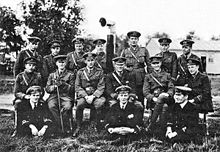Royal Naval Air Service
The Royal Naval Air Service , RNAS was until shortly before the end of the First World War , the air force of the Royal Navy . In 1918 it was merged with the Royal Flying Corps (RFC) of the British Army to form the Royal Air Force (RAF) .
history
When the RFC was founded on April 13, 1912, it was supposed to cover all military aviation. The Royal Navy, however, was not very pleased about the subordination of all naval aviation to the command area of the army and formed an unauthorized aviation division with a training center in Eastchurch . At the time, the Admiralty had enough political clout to ensure that this act went unchallenged. The Royal Naval Air Service was officially recognized on July 1, 1914.
At the beginning of World War I in August 1914, the RNAS had more aircraft under its control than the RFC. The Royal Navy maintained 12 airship ports along the British coast from Longside , Aberdeenshire in the northeast to Anglesey in the west.
On April 1, 1918, the RNAS was merged with the RFC. The Royal Air Force emerged as the first air force in the world to be organized in the form of an independent military service . At the time of the unification, the RNAS comprised 67,000 soldiers, 2949 aircraft, 103 airships and 126 bases. The RNAS squadrons have been integrated into the new structure. The individual seasons received new season numbers, in which 200 was added to their number. From the No. 1 Squadron RNAS became No. 201 Squadron RAF etc.
The Royal Navy got its "own" air force back in 1937 when the naval aviators, renamed the Fleet Air Arm, came under the control of the Admiralty.
Role and missions
The main tasks of the RNAS included the support of the fleet, coastal patrols to clear up enemy ship movements, attacks on the enemy coasts and the defense of Great Britain against air strikes. The RNAS systematically searched 4,000 square miles of the English Channel and the North Sea for submarines . In 1917 alone, 175 submarines were sighted and 107 attacked. Because of the submarine technology used at the time , the attacks were not very successful, but the sightings helped the fleet avoid casualties, divert convoys and ultimately sink enemy submarines.
Armored cars of the RNAS covered the retreat from Antwerp to the Yser in 1914 . Later in the war, RNAS squadrons were sent to the Western Front to support the RFC. The RNAS was also entrusted with the air defense of London . It also launched attacks on airship ports in the territory of the German Reich , including the base in Friedrichshafen, which is far from the sea .
Before techniques for landing and taking off on ships were developed, the RNAS had to use flying boats to operate at sea. Experiments began on the old cruiser HMS Hermes . Special flying boat tenders were developed to support these aircraft. These flying boat tenders launched attacks on German Zeppelin bases in Cuxhaven and Wilhelmshaven at Christmas 1914 . This was the first attack with ship-based aircraft. A number of bases were also built along the coast.
Famous pepole
- Henry Allingham - mechanic - oldest British man of all time, longest living member of the British Armed Forces (died July 2009)
- Richard Bell-Davies - 3 Squadron - received the Victoria Cross
- Henry John Lawrence Botterell - 8th Naval - longest surviving WWI fighter pilot (died January 2003).
- Raymond Collishaw - 10 Naval - best flying ace of the RNAS, with 60 kills
- Christopher Draper - 3 Wing, 6 Naval , 8 Naval - “The Mad Major”
- Bert Hinkler - Australian aviation pioneer
- Ivan Stedeford - industrialist
- Reginald Alexander John Warneford - received the Victoria Cross
- Josiah Wedgwood - got the DSO , commanded the machine guns on the SS River Clyde
- James White - 8 Naval Ass
literature
- Tim Benbow (Ed.): British Naval Aviation: The First 100 Years. Ashgate Publishing, 2011, ISBN 978-1-4094-0612-9 .
- Ian Philpott: The Birth of the Royal Air Force: An Encyclopedia of British Air Power before and during the Great War - 1914 to 1918. Pen & Sword, 2013, ISBN 978-1-78159-333-2 .
